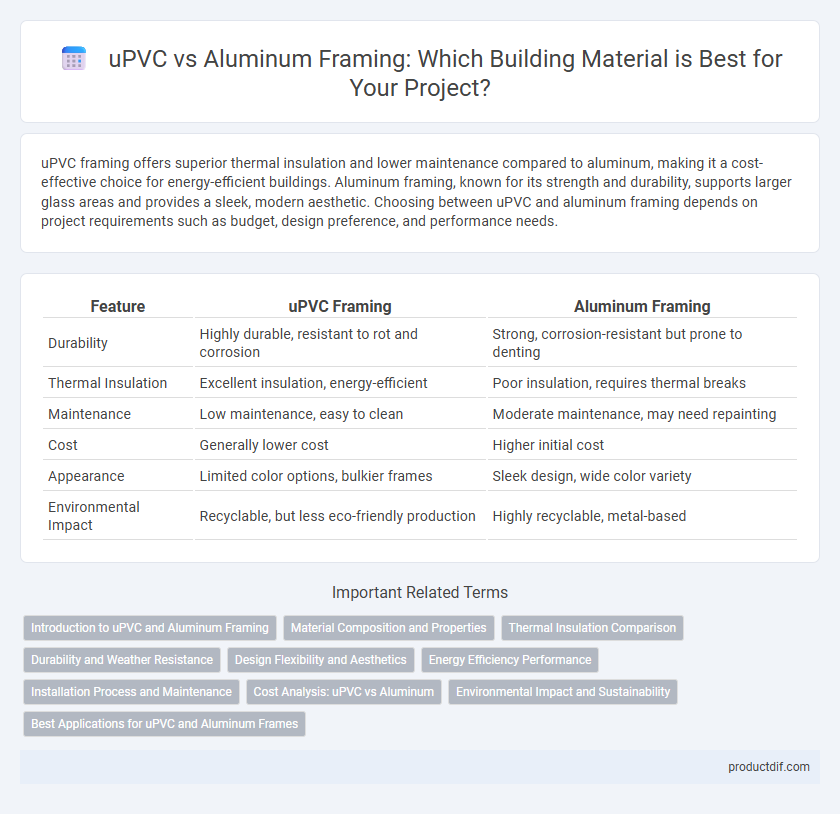uPVC framing offers superior thermal insulation and lower maintenance compared to aluminum, making it a cost-effective choice for energy-efficient buildings. Aluminum framing, known for its strength and durability, supports larger glass areas and provides a sleek, modern aesthetic. Choosing between uPVC and aluminum framing depends on project requirements such as budget, design preference, and performance needs.
Table of Comparison
| Feature | uPVC Framing | Aluminum Framing |
|---|---|---|
| Durability | Highly durable, resistant to rot and corrosion | Strong, corrosion-resistant but prone to denting |
| Thermal Insulation | Excellent insulation, energy-efficient | Poor insulation, requires thermal breaks |
| Maintenance | Low maintenance, easy to clean | Moderate maintenance, may need repainting |
| Cost | Generally lower cost | Higher initial cost |
| Appearance | Limited color options, bulkier frames | Sleek design, wide color variety |
| Environmental Impact | Recyclable, but less eco-friendly production | Highly recyclable, metal-based |
Introduction to uPVC and Aluminum Framing
uPVC framing, made from unplasticized polyvinyl chloride, offers excellent thermal insulation, weather resistance, and low maintenance, making it a popular choice in modern construction. Aluminum framing provides superior strength, durability, and design flexibility, often used in commercial and high-end residential buildings for sleek, lightweight structures. Both materials are key in sustainable building practices, with uPVC excelling in energy efficiency and aluminum favored for its recyclability and long lifespan.
Material Composition and Properties
uPVC framing consists mainly of unplasticized polyvinyl chloride, offering excellent thermal insulation, resistance to corrosion, and low maintenance requirements. Aluminum framing, made from lightweight yet durable metal alloy, provides superior strength, enhanced structural integrity, and excellent resistance to weather elements but has higher thermal conductivity than uPVC. Both materials have distinct advantages in durability and energy efficiency, with uPVC excelling in insulation and aluminum favored for modern aesthetics and robustness.
Thermal Insulation Comparison
uPVC framing offers superior thermal insulation compared to aluminum due to its low thermal conductivity and multi-chambered profiles that reduce heat transfer. Aluminum frames require thermal breaks to prevent heat loss and condensation, but they still conduct more heat than uPVC. Choosing uPVC can significantly enhance energy efficiency and indoor comfort by minimizing heat exchange in building envelopes.
Durability and Weather Resistance
uPVC framing offers superior durability with its resistance to corrosion, rot, and termites, making it ideal for harsh weather conditions. Aluminum framing provides excellent weather resistance due to its strength and ability to withstand extreme temperatures without warping or cracking. Both materials deliver long-lasting performance, but uPVC tends to perform better in humid climates while aluminum excels in areas exposed to intense sunlight and wind.
Design Flexibility and Aesthetics
uPVC framing offers superior design flexibility with its ability to be molded into various shapes and sizes, enabling customized and intricate window profiles that enhance aesthetic appeal. Aluminum framing, known for its slim sightlines and sleek modern look, provides a contemporary aesthetic with a high strength-to-weight ratio, allowing for larger glass panels and expansive views. Both materials support diverse architectural styles, but uPVC excels in adaptability for detailed design, while aluminum stands out for minimalist and high-performance applications.
Energy Efficiency Performance
uPVC framing offers superior energy efficiency compared to aluminum due to its low thermal conductivity, significantly reducing heat transfer and improving insulation in buildings. Aluminum frames require thermal breaks to enhance their energy performance, but they still generally exhibit higher heat loss than uPVC. Energy-efficient windows and doors using uPVC can lower heating and cooling costs, contributing to sustainable building design.
Installation Process and Maintenance
uPVC framing offers a straightforward installation process due to its lightweight nature and flexible design, reducing labor time and costs compared to aluminum framing, which requires specialized tools and skills for precise fitting. Maintenance of uPVC is minimal, involving simple cleaning to prevent discoloration and inspections for seals, while aluminum frames demand regular checks for corrosion and repainting to maintain structural integrity and appearance. Both materials require appropriate weatherproofing measures, but uPVC generally outperforms aluminum in energy efficiency and long-term upkeep.
Cost Analysis: uPVC vs Aluminum
uPVC framing generally offers a more cost-effective solution compared to aluminum, with initial material and installation expenses often 20-30% lower. Maintenance costs for uPVC remain minimal due to its resistance to corrosion and weathering, whereas aluminum requires periodic coatings to prevent oxidation, increasing long-term expenses. The thermal efficiency of uPVC also contributes to energy savings, reducing utility bills over time compared to aluminum frames.
Environmental Impact and Sustainability
uPVC framing offers excellent energy efficiency due to its low thermal conductivity, significantly reducing heating and cooling demands in buildings, and it is recyclable, though the process is complex and less widespread. Aluminum framing is highly durable and fully recyclable, with a well-established recycling infrastructure that reduces raw material extraction and lowers overall environmental impact. The production of aluminum, however, consumes more energy and generates higher emissions compared to uPVC, making the lifecycle sustainability of each material dependent on specific project goals and local recycling capabilities.
Best Applications for uPVC and Aluminum Frames
uPVC frames are best suited for residential buildings due to their excellent thermal insulation, low maintenance, and cost-effectiveness, making them ideal for windows and doors in moderate climates. Aluminum frames excel in commercial and high-rise buildings where strength, durability, and slim profiles are required to support large glass panels and withstand harsh weather conditions. Both materials offer energy efficiency and weather resistance, but aluminum is preferred for modern architectural designs demanding sleek aesthetics and structural integrity.
uPVC vs aluminum framing Infographic

 productdif.com
productdif.com